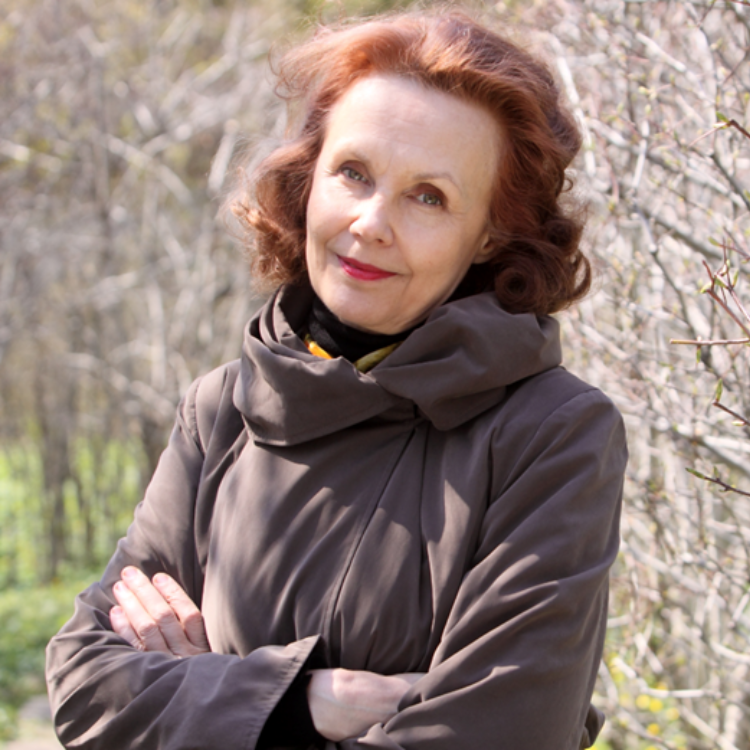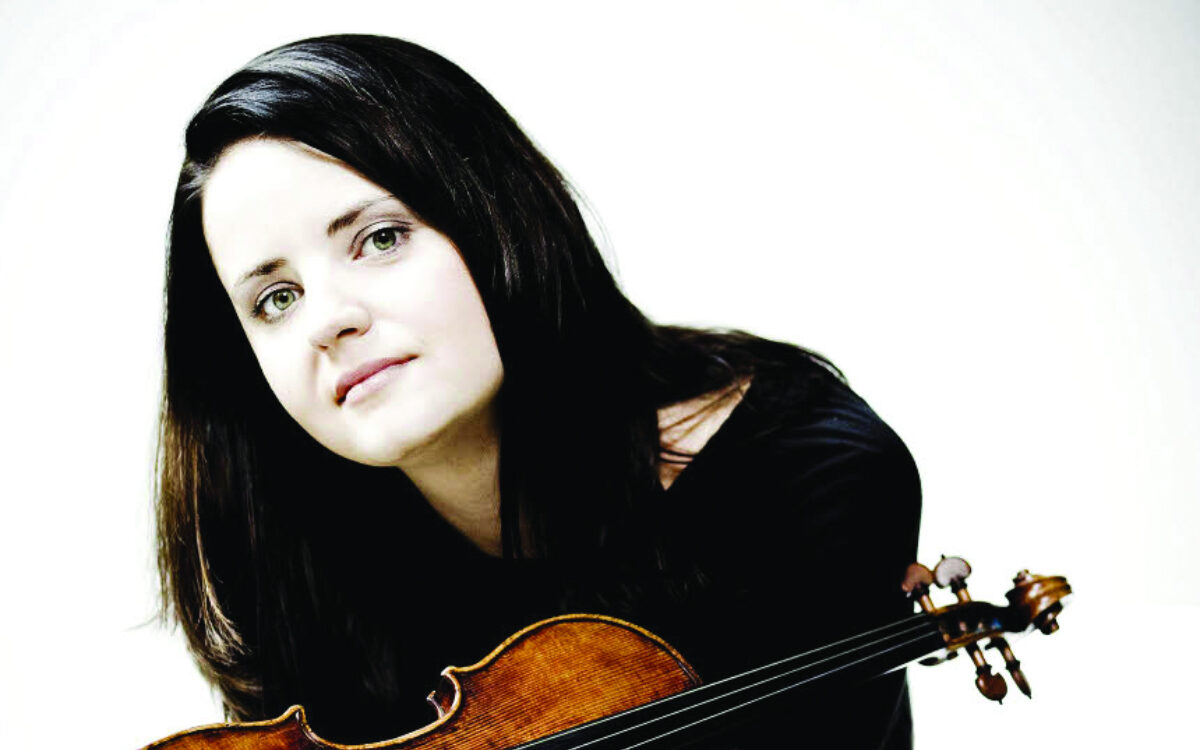Saarikoski Songs, for soprano and orchestra
Quick Facts
- Composer’s life: Born October 14, 1952, in Helsinki, Finland
- Year completed: 2021
- First BSO performance: February 24, 2022, Andris Nelsons conducting, with soprano Anu Komsi as soloist (world premiere)
- Approximate duration: 15 minutes
Kaija Saariaho was born in Helsinki, Finland, on October 14, 1952, and has lived primarily in Paris since 1982. She composed her Saarikoski Songs at the suggestion of soprano Anu Komsi, beginning with “Luonnon kasvot” (“The face of nature”) in 2013, originally intended as a standalone work, and adding to the cycle song-by-song through the 2020 composition of “Minussa lintu ja käärme” (“In me the bird and the snake”) and “Sumun läpi” (“Through the mist”). Anu Komsi and pianist Pia Värri gave the premiere of the cycle for soprano and piano in Kokkola Centria Hall, Finland, on January 4, 2021; the score is dedicated to Anu Komsi. Created in 2020-2021, the orchestral versions were co-commissioned by the Gewandhausorchester Leipzig, Andris Nelsons, Gewandhauskapellmeister, and the Boston Symphony Orchestra, Andris Nelsons, Music Director, through the generous support of the Arthur P. Contas Fund for the Commissioning of New Works. These are the world premiere performances.
The score of Saarikoski Songs calls for solo soprano with a small orchestra of flute, alto flute (doubling piccolo), oboe, English horn, clarinet, bass clarinet, bassoon, contrabassoon, 2 horns, trumpet, percussion (1 player: xylophone, marimba, crotales, suspended cymbals, triangle, tam-tam, wood blocks, wood chimes, guiro, glass chimes, tambourine, small bell, snare drum, frame drum, bass drum), timpani (with large cymbal and temple bowl), celesta, and strings (first and second violins, violas, cellos, and double basses). The cycle is about 15 minutes long.
Kaija Saariaho’s earliest celebrated works, from the mid-1980s, were remarkable for their intense concentration on the quality of sound itself, whether instrumental or electronic or both, but text and the voice are a fundamental part of her work and process. The progression from concentrated studies like Lichtbogen, in which a single sound gesture is explored and exploded over a 20-minute span, through her Six Japanese Gardens for percussion and electronics and Papillons for solo cello, reveals an organic evolution of increasingly nuanced and imaginative control over not only the minute details but the overall, large-scale impact.
The ways Saariaho engages with the sound of language and its meaning in her music are completely consonant with her explorations in pure sound. The expressive potential of a word, encompassing its “pure” meaning but also its context within a larger text, its sonic reality, and the way it’s delivered by the singer/speaker all factor into how she brings language into her music. Conversely, the bigger picture of narrative and image-painting with text as a basis has been the foundation of many of her purely instrumental works, such as in her violin concerto Graal théâtre. Correspondences between her explicitly dramatic works and her concertos, orchestral music, and instrumental chamber music abound and reflect Saariaho’s overall approach to her art, which also touches on fascinations with the natural world and with visual art.
Saariaho’s native language, Finnish, became a sonic source subject to fragmentation and deconstruction in her early vocal triptych Preludi–Tunnustus–Postludi, but until relatively recently Saariaho’s major vocal works have been in French and English. These include her five operas, the best-known of which is the French-language L’Amour de loin (“Love from Afar,” 2000). The cantata La Passion de Simone, like her first three operas, features text by the Lebanese-French poet Amin Maalouf. As part of her work on L’Amour de loin, which centers on the 12th-century troubadour Jaufré Rudel, she created her soprano-and-electronics piece Lonh from Jaufré texts in the poet’s own Old Occitan language. Her opera Innocence, premiered last year at the Aix-en-Provence festival, is based on the work of the Finnish playwright Sofi Oksanen translated primarily into English, but many of the characters sing in one of nearly a dozen other European languages. Her Circle Map, co-commissioned by the Boston Symphony Orchestra, creates a kind of text collage from poems in Persian by Rumi. (The BSO also co-commissioned Saariaho’s cello concerto Notes on Light.)
In 2007 Saariaho wrote a song cycle for voice and piano on texts by the Finnish poet Eino Leino (1878-1926), one of the founders of modern Finnish poetry (and poet of Jean Sibelius’s 1920 cantata Hymn of the Earth), at the request of the Finnish soprano Anu Komsi. Saariaho later made an orchestral version of the cycle. It was at Komsi’s suggestion that Saariaho set the Finnish writer Pentti Saarikoski’s poem “Luonnon kasvot” (“The face of nature”) in 2013; as the composer writes, the song was intended as a one-off:
Unlike [the poet Eino] Leino, Saarikoski has been a poet close to my heart ever since my student years. However, I had never even contemplated the idea of setting his poetry to music, because it doesn’t require any, nor does it seem to clearly open the door to it.
However, when in 2013 I started composing Luonnon kasvot (“The face of nature”), which was then intended as a standalone song, living inside Saarikoski’s text proved an invigorating experience, that demanded that I create an approach closer to natural orality. This material didn’t lend itself to the stretched vocals that felt so organic in the process of approaching Leino’s poetry, and indeed they would have immediately come across as artificial.
The approach to the text felt new and almost too unadorned, which is why in “Luonnon kasvot” the text is complemented by abstract bird-like vocalizations.
The next songs came spontaneously over the years, and are very different from each other, as are the poems, all taken from the collection Alue (“The District”). In 2017, “Jokaisella on tämänsä” (“Everyone will have their own this”) brought a more dramatic expression into the cycle’s world, surprisingly soon followed by the peaceful “Kaikki tämä” (“All of this”), written in one single sunny day in the French countryside—whereas “Minussa lintu ja käärme” (“In me the bird and the snake”) and “Sumun läp” (“Through the mist”) were created in Finland, during the corona-spring of 2020, and the texts have an evident connection to the feelings of that time.
During the entire fragmented composition process, the poems planted their seeds in me as musical ideas at specific moments, when they spoke to me in a particular way.
Pentti Saarikoski (1937-83) was among the most important poets of post-World War II Finland; his approach to a natural, modernized vernacular language, an ironic but nonetheless informed view of tradition, and a wild lifestyle that seemed like a performance in itself suggest parallels to the Beat and modernist poets in the U.S. He was one of most formidable translators into Finnish of many important works of Western literature, including Homer’s The Odyssey and other ancient classics as well as such modern authors as James Joyce (Ulysses), J.D. Salinger (The Catcher in the Rye), and Ezra Pound. As critic and translator Anselm Hollo describes him, “Saarikoski…was a highly literate and iconoclastic left-wing radical…a youth idol—the popular press referred to him as “The Blond Beatle of the North”—whose often scandalous public behavior and pronouncements, combined with his introduction of uninhibited Finnish vernacular into the language of literature…shocked many of his elders in much the same way that William S. Burroughs and Allen Ginsberg jolted the establishment in the United States.”
The poems of Saarkoski Songs are all taken from his 1973 collection Alue (“The District”). In a preface to his translation into English of the poems in Saariaho’s Saarkoski Songs, writer and director Aleksi Barrière writes,
The collection Alue (“The District,” 1973) is a break from Pentti Saarikoski’s output of the 1960s, which was centered on political commentary and poetry as a means for social transformation. It was also written shortly before his separation from his wife and self-imposed exile to Sweden, where he authored his last works, inspired by a renewed interest in Greek mythology. The text of Alue is written in the form of unnumbered fragments, comprising reflections on the author’s life, his walks in the Helsinki neighborhood of Pohjois-Haaga with his child between winter and spring, and the destruction of the nearby forest to give way to new apartment buildings.
In her piano-vocal versions of the songs, Saariaho, though making sure the voice presents the language as language, also moves the singer into the realm of the wordless instrumental, not just as an illustrating device (as in the birdlike trills of the first song) but also in extensions of syllables that leave one’s immediate grasp of a word’s meaning behind. The piano, too, is often pushed out of its wonted role: the extremes of register and specific, blurring use of the sustain pedal create sound-fields that amplify the imagery painted by the singer’s words. Clouds of sound produced by playing within the strings (that is, inside the piano without use of the keys) already foreshadow the much greater acoustic range of the orchestra. As in the Leino Songs, in the orchestral versions of Saarikoski Songs the blending of ensemble and vocal roles expands the possibilities exponentially. A powerful melodic idea, a four-note motif of two half-step intervals separated by a major third, creates a harmonic and melodic connection binding the cycle together. The idea can almost be thought of as a version of the trill that appears throughout the first song, “The face of nature.” These vocal ideas are both anticipated and echoed in the orchestra in constantly changing, pointillistic colors—a flute, a violin, percussion in quick succession. Listen to the way the trill is brought into the entire string section at the end of the first song, for example.
The longer lines of the first song become the fragmented and clipped, excited vocal gestures of the second song, “Everyone will have their own this,” the orchestral accompaniment of which is mosaic-like in its accumulation of small fragments. The third song, “All of this,” is a dark, slow lament. The two horns, trumpet, and percussion join the strings for its somber backdrop. With a foundation consisting almost entirely of a rapidly repeated pitch A in different octaves and instruments, the recitative-like “In me the bird and the snake” highlights the outsized role timbre plays in defining the cycle’s sound-world. The two-line poem of the final song, “Through the mist,” suggested the timeless, “misterioso” setting in which the orchestra provides the text’s ambiguous, ethereal meaning.
Robert Kirzinger
Composer and writer Robert Kirzinger is the Boston Symphony Orchestra’s Director of Program Publications.


